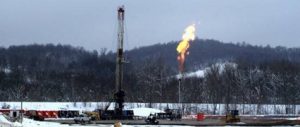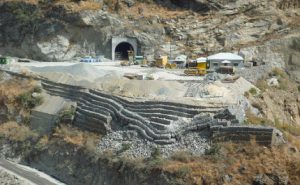China has become one of Asia’s leaders in expanding unconventional shale-gas extraction in the name of energy self-sufficiency and national autonomy. Experiences of “fracking” worldwide, however, suggest the costs to China of joining this revolution will be loss of control of natural resources and land to major corporations, with negative social and environmental consequences for many communities.
Rising oil prices, concerns about “peak oil” and growing public awareness of environmental depletion have made diversification of energy sources in a “sustainable” manner an urgent worldwide priority for governments and corporations.
In this context, unconventional natural gas is increasingly hailed as a triple win in terms of energy self-sufficiency, economic development and environmental benefits. Extracted through a newly applied use of hydraulic fracturing technology more commonly referred to as “fracking”, it is promoted by the gas industry as a route to lower greenhouse gas emissions – a “transition fuel” that can bridge the shift from a fossil-based economy towards a renewably powered future.
Unconventional gas exploitation has also been embraced by the US as a potential solution to energy insecurity and a geopolitical “game changer”.
China’s shale gas reserves “largest in world”
China has enthusiastically joined this scramble and emerged as an Asian pioneer of unconventional shale gas production, describing it as “a ‘revolution’ to increase domestic gas supply, improve the energy mixture and protect energy security”. The government has set a target for the industry to pump 229 billion cubic feet of natural gas from underground shale formations a year by 2015; and by 2020, the nation’s goal is for shale gas to provide 6% of its energy needs.
Fracking has particular appeal for Chinese policymakers, because of the size of the country’s gas reserves. A recent report by the Ministry of Land and Resources claims China holds the largest onshore shale gas reserves in the world at around 4,800 trillion cubic feet, lying mainly in the Sichuan and Tarim Basins in southern and western China. This would, it is argued, free China’s growth from a key Achille’s heel – its reliance on imported energy.
The government is also determined to support the sector’s development, because it seemingly provides a way to reduce the national carbon footprint, as 70% of the nation’s consumed energy is currently supplied by burning coal.
However, Chinese fracking “know-how” is meagre. As a result, China has encouraged energy companies China National Petroleum Corporation (CNPC), China Petroleum and Chemical Corporation (Sinopec) China National Offshore Oil Corporation (CNOOC) to form partnerships with foreign oil companies. Chesapeake Energy, ExxonMobil, BP, Chevron and Total have all embarked on multi-billion dollar deals, while Shell has announced a shale gas joint venture with CNPC to operate a 3,500 square-kilometre concession in the Sichuan Basin.
This state-foreign capital alliance notably lacks any real environmental law protection in spite of the proven risks from the US and elsewhere. The risks are directly linked to the technology and its application.
Risks of fracking
Fracking is a multi-stage process that involves drilling 3-6 kilometres below the Earth’s surface through underground freshwater sources to reach shale or coal bed formations; then drilling horizontally for up to 2 kilometres and blasting a series of fractures to create fissures to release natural gas trapped in the deep rock formations; before finally bringing the deposits up to the surface through high-pressure injection of frac fluid (water, sand and toxic chemicals) into the drilling well.
Each stage entails considerable risks. Cement-casing failures may allow methane and other hazardous chemicals to migrate to water sources and water wells. The fracking inputs contain known carcinogens and air pollutants, which can leak into ground and surface water during the fracking process. BTEX compounds such as benzene, toluene, xylene and ethylbenzene, notorious for their harmful effects on the central nervous system, have been found in hydraulic fracturing products used in the US between 2005 and 2009.
Water contamination can result from accidental spills during truck transportation, leakages through cracked or corroded cement casing of the wells, or as fugitive gas through the rock fractures themselves. Wastewater, known as “produced water”, poses serious risks. For every million gallons of chemical-laced frac fluid injected down the drill wells, 20-40% will be regurgitated back to the surface, bringing with it: chemicals, traces of oil-laced drilling mud, and all the other toxic substances previously trapped in the rock – such as iron, chromium, salt, and radioactive materials including Radium 226.
Most water treatment facilities today are not designed to handle fracking wastewater. As a result, much of it ends up sitting in large ponds and eventually entering rivers and streams. Meanwhile, fracking can also cause earthquakes, as happened in Lancashire in the United Kingdom and Oklahoma and Arkansas in the US. (See TNI’s full briefing on fracking).
Not enough water
All of this casts doubt on the seemingly “transitional” and “cleaner” aspect of the Chinese fracking boom. The boom is most likely to breathe new life into the corporate oil industry’s constant search for new avenues for profit, and it will undermine the Chinese people’s possibilities for control of resources and their environment.
One issue in China perhaps highlights this more than any other, and that is the way fracking will exacerbate “water grabbing”. To achieve the target of 229 billion cubic feet of shale gas will require no less than 485 million cubic feet of water. Yet, according to the same source, “most of the nation’s shale gas lies in areas plagued by water shortages”. A recent drilling test operation in Northern Shaanxi Province encountered complications, forcing local officials to temporarily cut a nearby city’s water supply. These risks are all the more threatening in a country that already faces major water stress.
China’s embrace of fracking may seem attractive on the surface, but its darker consequences are already becoming obvious. Handing over power to determine how land and water is used and how the environment is managed to fracking corporations and their quest for profit is not a path to a sustainable and liveable future for China’s citizens.





